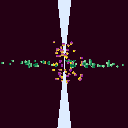
 The basic idea is that all of the active galaxies (quasars, Seyfert, radio galaxies) which we observe have the same internal structure in their nucleus.
The basic idea is that all of the active galaxies (quasars, Seyfert, radio galaxies) which we observe have the same internal structure in their nucleus.
At the center is a super massive black hole (typically a billion solar masses). A very small torus around the black hole drives a perpendicular jet like a water hose nozzle.

About 100 light days out from the accretion disk one finds the broadline region of gas clouds. These clouds produce the unusually broad emission features seen in some AGN (Seyfert 2).
Beyond and outside of that, one finds the molecular torus and then further still, the narrow line region, which produces the narrow emission lines seen in some AGN (Seyfert 1).